The scale of the mobile gaming industry is overwhelming. As of summer 2014, more than 75 billion apps were downloaded from the App Store. Games made up the highest percentage at over 21% of the total downloads. Not only that, games are the top grossing app category in the app stores. In 2015, mobile games are predicted to surpass console game revenues for the first time. On Apple’s Best of 2014 list , 9 out of the 10 top grossing apps throughout 2014 were games. In the same year, games delivered around 75% of income on the app store. When the top games are raking in over a million dollars a day , and user acquisition costs have risen 34% in the last year , what can smaller developers do to get discovered and grow? Additionally, what can larger mobile game developers do to keep their costs down?
Mobile game developers offer some of the best insights. At our recent meetup at Yahoo , Josh Lu, Director of Product at Zynga, talked about how they determine if a new user is likely to become a paying customer, and how they change their ad and growth tactics for this user as a result. When Michael Dawson, Head of Business Development and Strategy at Pocket Gems spoke at our 500 startups meetup , he hinted at the many ways game developers acquire new users such as performance buying, brand advertising, game-to-game promotions, video advertisements, and the success of the free-to-play (F2P) model. At the same time, Apple’s crackdown on incentivized installs restricts gaming apps from “paid bursting” onto the featured lists where they are likely to get noticed and grow organically from there. As a result, game developers are desperately searching for new ways to gain users at low cost.
Contextual deep linking is the answer to this search. With proven results in other verticals, such as a 48% increase in conversion to signups in travel apps, and a 30% increase in installs through user referrals in dating apps, Branch links are the essential tool for game developers and marketers.
And to push the industry further, we announced a partnership with mNectar earlier this week tailored to deliver the most innovative gaming ads available. mNectar’s playable ads, with embedded deep links, allow users to play games in the ads and continue where they left off in the game after install. Additionally, we’ve created a Unity wrapper that allows developers on the unity platform to easily and quickly build with the power of Branch. But the value of deep links for mobile games doesn’t stop there. In order to demonstrate the power of deep links for mobile games, we’ve created example use cases for games from Big Fish, Two Dots, and Zynga.
Big Fish Games
Big Fish Games is one of the largest mobile game developers in the world. They create hundreds of games for desktop, online, and mobile. Their flagship mobile game Big Fish Casino can be used as a great example of how a deeplinked sharing program can drive and retain new users.
Currently, Big Fish Casino has a system in place to invite users to empty seats at your blackjack or poker table. This feature is a creative way to engage your friends, but when you click on the sharing icon you can only invite people via Facebook. Not only that, the person must have already downloaded the app and connected it to Facebook. This limits the potential to drive new installs and restricts the number of new users a current user can reach.
Now imagine that you could invite anyone, on any platform, to join your table and play. After clicking the same sharing icon, a personalized invite and associated deep link is generated that can be shared via email, text, or social media. The referred user clicks on the link, from any device, and is brought to the Big Fish Casino app in the app store. Upon downloading and opening the app for the first time, the new user is linked directly to the table their friend is playing at. No need to manually search or enter promo codes to reach the table. Not only that, to increase the chances they will invite friends, you can utilize a referral program to reward the referrer and the new user with chips to start playing with. As seen in Vango’s 2x increase in one-week retention , contextually deeplinking to the content that drove a new user to an app can pay large dividends.
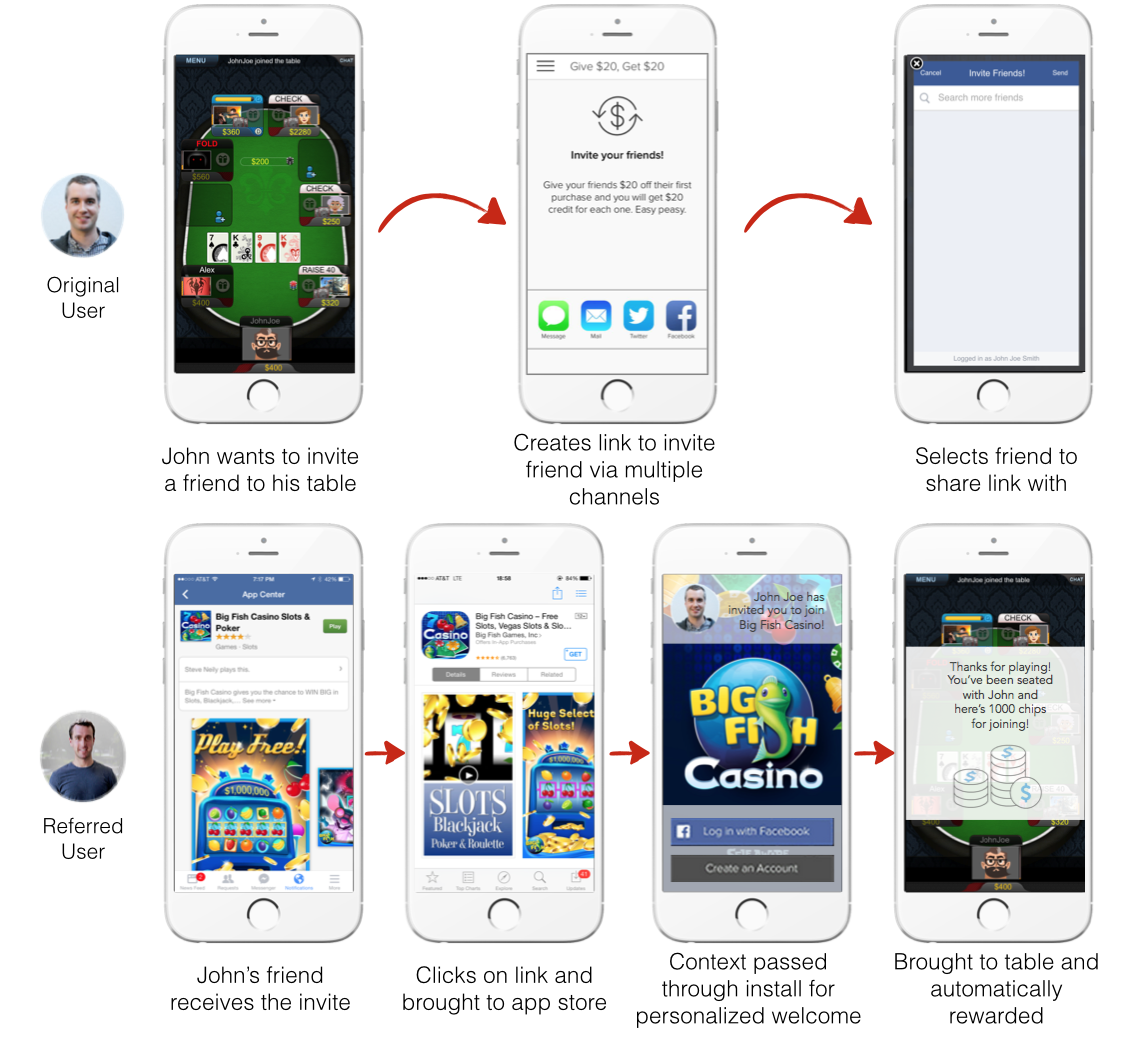
Two Dots
Two Dots is a new F2P puzzle game that has gotten a lot of attention lately. The minimalist, single-player sequel of Dots delivers accessible and satisfying challenges that have allowed it to find enormous success.
Two Dots does a great job of incorporating gamification tactics. Leveling up, badges in the form of postcards and medals, and leaderboards all create retentive users. However, Two Dots doesn’t have many features within the app that are focused on acquiring new users. Currently, they have a sharing feature that allows users to text your accomplishments to friends in their contacts as an invite to play the game. This invite is non-personalized and non-incentivized, likely resulting in fewer clicks. Not only that, the current sharing URL provided isn’t hyperlinked, creating another barrier to install as potential new users have to manually enter or copy and paste the link into their mobile web browser. Additionally, this URL is generic for the app store so no contextual information is passed through install. As a result the first experience upon opening that app is a standard welcome screen with no context referring to who, or how, they got there.
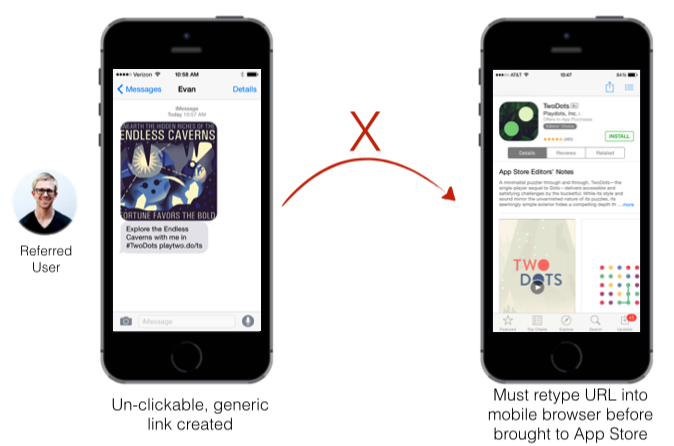
With deep links, the sharing experience can be incentivized and the new user flow would change. A unique link would be generated for each share that is associated with that referrer. The link can be shared via text, email, or social media. If a new user clicks the link, they are brought directly to the app store to download the app. Once the app is downloaded, they are directed to a customized welcome from the referring user, increasing their retention. Since the deep link can track this referring information, these two users will now be connected in the game, such as on the same leaderboard, without any additional steps. This not only improves user experience, conversions, and retention, it allows games to track which users and growth campaigns are responsible for the most downloads.
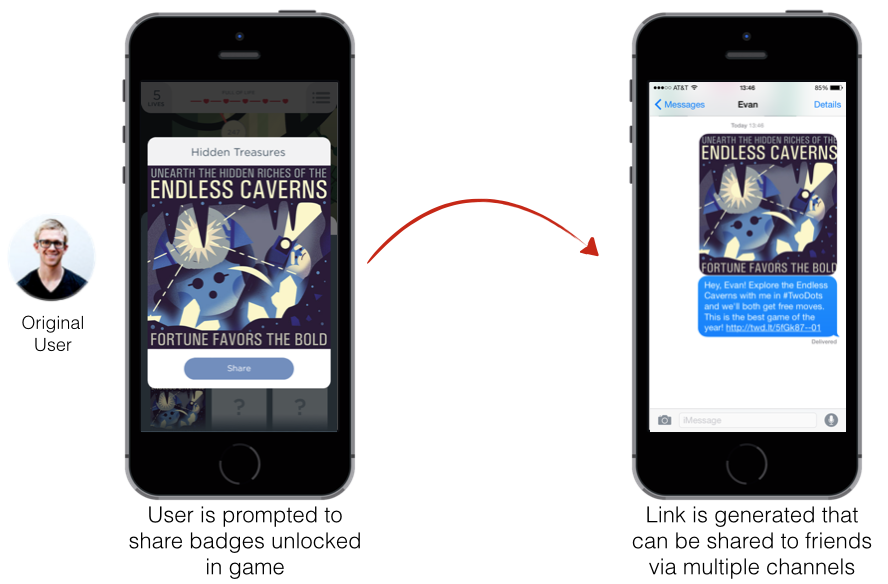
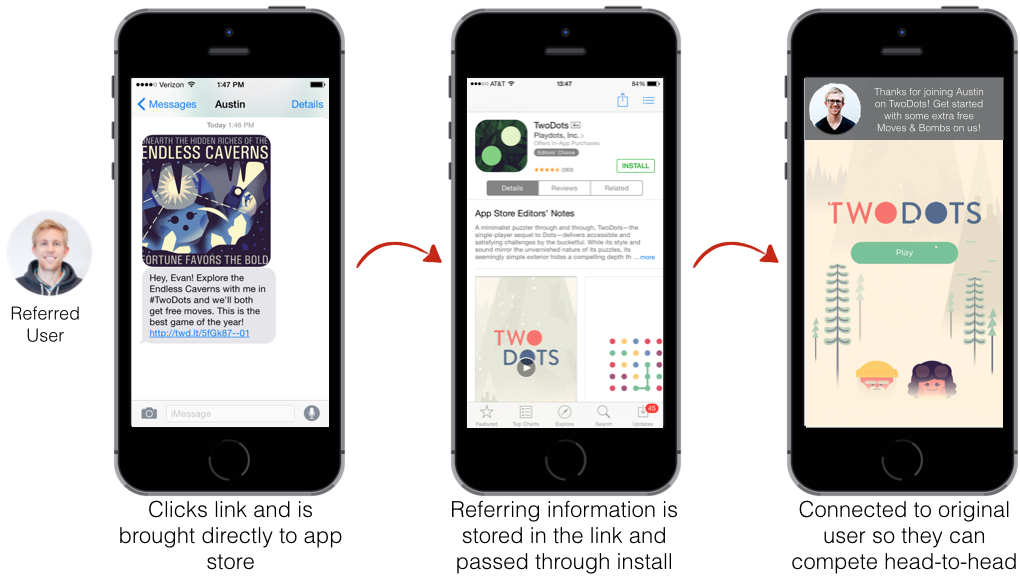
As a F2P game, Two Dots relies on in-app purchases for revenue. As is standard in the gaming industry, most revenue in these type of games come from “ whales ,” big money spenders that make up a low percentage of total users. In fact, a mobile monetization report in 2014 found that half of F2P in-app purchases came from 0.15 percent of players . Shocking right? So as a game developer, how can you turn the larger, non-paying players of your game into valuable users? The answer: get them to share your game.
CandyCrush used a similar technique to drive the viral growth of their app. In order to reach certain levels, users had to invite friends to play the game. Deep links take that one step further by allowing you to reward the referrer AND the new user if they install the app. By incentivizing installs, rather than invites, you are measuring the metrics you really want to see. And with deep links, this all occurs in a seamless UX with no promo codes or extra steps.
Two Dots currently prompts you to buy Moves and Bombs if you run out of moves on a certain level. After a few failed levels, they’ll have a good understanding of if a user is likely to ever take up this offer. If a user has established themselves as a non-paying player, as most do, its time to try something else. Instead of paying, Two Dots can encourage them to get a friend to download the app in order to get the free Moves and Bombs. Users can create and share a deep link, similar to before. Once a new users downloads and opens the app, they will be rewarded with the supplies needed to complete the level and their friend will be acknowledged for their assist.
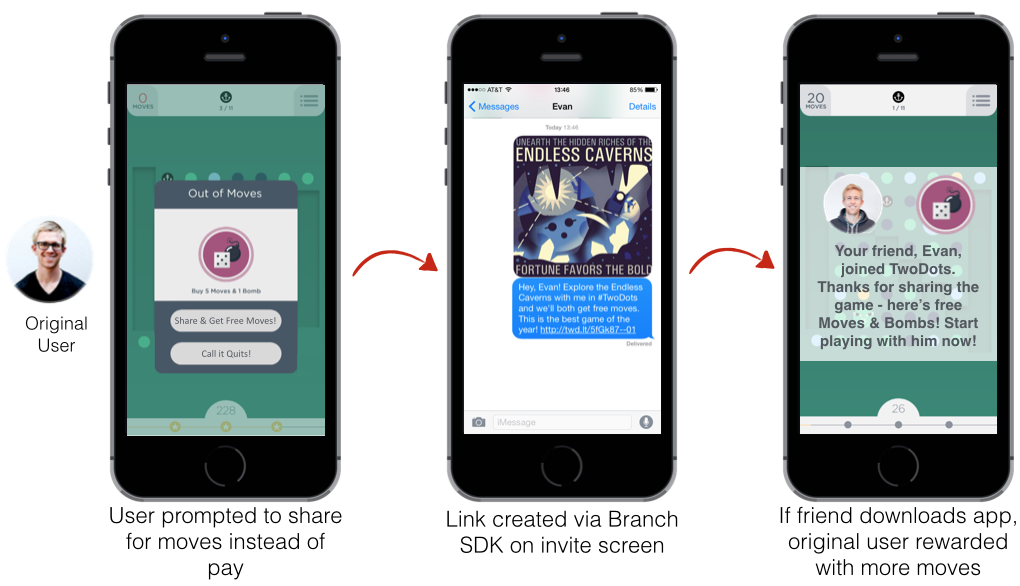
Zynga
Zynga is one of the largest mobile game producers in the world. Over the years they’ve had a number of hits at the top of the install and grossing charts. As the mobile gaming market begins to mature they have to deal with an increasing number of competitors in an increasing number of game types.
Even for some of the larger game developers, deep linking provides a valuable tool to promote growth and measure attribution, for free. When you’re spending close to $4 per user on acquisition, and have millions of users, keeping costs down will have a large impact on the bottom line. The popularity of games like FarmVille and Words with Friends has given them a large Twitter following. Although this is a great forum to interact with users and provide updates, they aren’t able to currently utilize this Twitter following to bring new users directly to the game.
For a limited time, new “Get Your Hands on Fingerling Potatoes” items are available! View details: https://t.co/Q46MkxaW8e #FarmVille2onWeb
— FarmVille 2 (@farmville2) March 30, 2015
For example, their current campaign sounds like it’s offering in-game items for clicking on the link. However, this link only brings users to the website where they announce that the items in the General Store. With deep links, this link could bring users directly to the app where they are rewarded with the gift upon opening. All mobile app developers want users spending as much time as possible in native apps. It’s where they’ve spent their time optimizing user experience and profit from users. Deep links bring users directly to the content that drove them to the app, wherever that may be.
Lets look at an example that uses social media as a way to encourage users to bring their friends to the app, regardless of if they are current users or not. Many Zynga games they feature a Social Center to encourage users to Tweet and Share different aspects of the game. They currently don’t have many incentives to utilize this feature but deep links can encourage people to share much more. Deep links would allow Zynga to incentivize users with in game credits for having friends download the app. Current game incentives are limited in their function. Apps can either incentivize shares, resulting in increased sharing but not necessarily downloads, or incentivize downloads, which depends on a new user entering a promo code associated with the referring user. Deep links allow apps to incentivize installs without relying on the extra steps of searching for friends or entering promo codes.
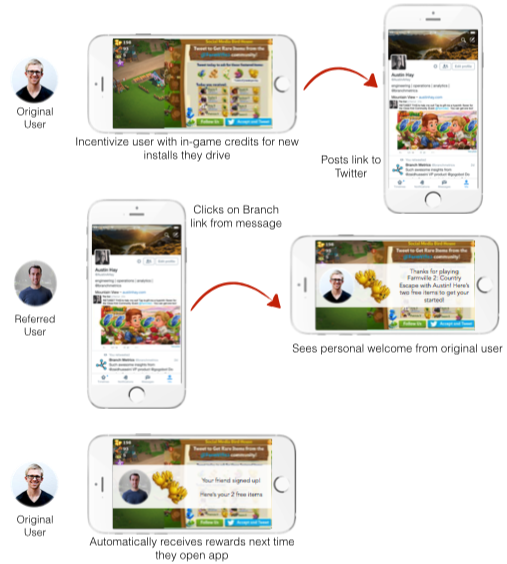
Endless Value with Contextual Deep Links
All mobile games depend on organic growth. In such a large and competitive industry, any change in retention, virality, or user experience can be the difference that drives you towards the critical mass of users necessary for your game to succeed. For small game developers, deep links provide a channel to support viral growth without relying on paid user acquisition. For large companies, deep links can promote an increased ROI by improving UX and reducing the number of steps in the conversion of a new user. These Two Dots, Zynga, and BigFish examples were used to show the versatility of deep links across multiple types of mobile games. In addition, deep links work across multiple platforms meaning the same link works on desktop, Android, and iOS. There are a few deep linking solutions on the market but only one that promises all of the features described above while remaining completely free.
Sign up if you’re ready to use deep links to improve the growth and profitability of your mobile game.






















